Drug Treatment and Rehabilization
| Reports - Annual Report on Drug Control in China 2008 |
Drug Abuse
Drug Treatment and Rehabilization
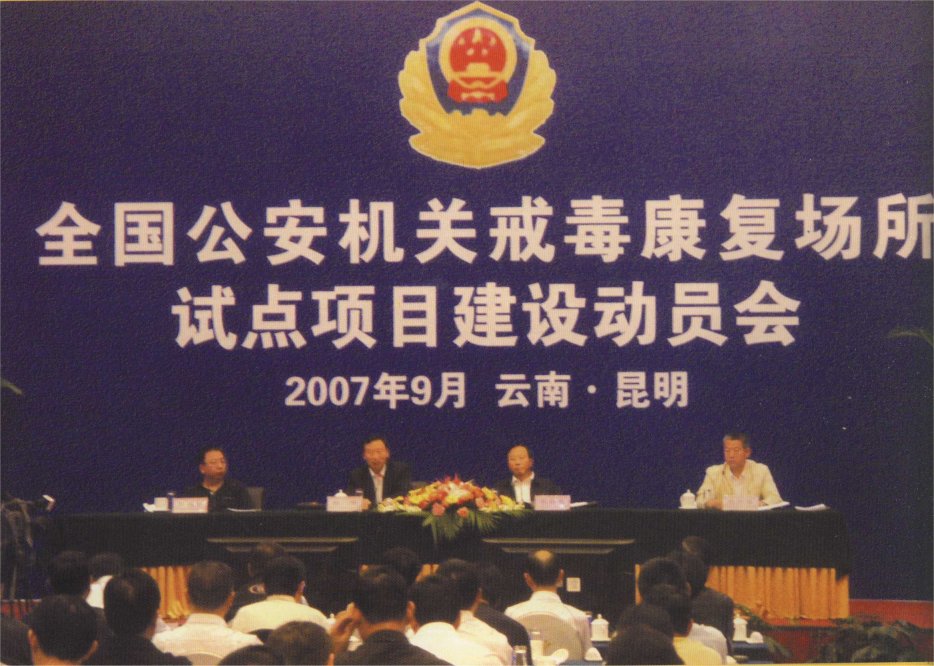
In 2007, drug control agencies of all levels took with the construction of drug abusers' dynamic monitor and control system and the drug rehabilitation centers as a breakthrough point, continued to check and monitor, receive and treat, help and educate the drug abusers, and coordinated and promoted the methadont maintenance for opiate abusers. The drug treatment and rehabilitation were improved to a higher level.
Promoting the establishment of drug abusers dynamic monitoring system, consolidating the working foundation of drug demand reduction
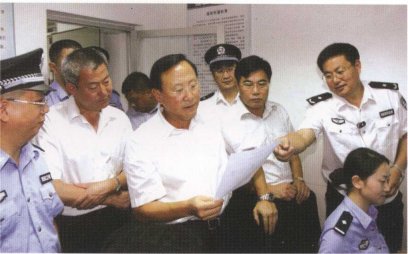
Mr. Zhang Xinfeng inspects the construction of Dynamic Monitor System for Drug Abusers in Shenzhen
The narcotics control, public order, border control, criminal investigation, prisons administration and justice agencies closely cooperated with each other to promote vigorously the general screening and information collection on drug abusers. Up to the end of March 2007, all relevant agencies had successfully completed the task of the phase, i.e. inputting all information to the on-line database on the drug abusers whom the police could see face-to-face. The information management platform of the dynamic monitor and control system for drug abusers had been established tentatively, the baseline data and current situation of all drug abusers in China were grasped more precisely. The system had achieved dynamic tracking as well as on-line search and statistics. There had been 955 thousand drug abusers in the national drug abusers database. For the sake of a long-term effective system, the Ministry of Public Security issued "The Notice on the Enhancement of Working Mechanism on Dynamic monitor and control System for Drug Abusers"and "The Check and Evaluation Methods in Public Security Agencies on Dynamic monitor and control System for Drug Abusers", strengthened the discovery of drug abusers and the implementation of monitor responsibility. In 2007, the public security agency discovered and punished more than 122 thousand relapse drug abusers, captured more than 3000 fugitives. The public security agencies of Shenzhen of Guangdong Province, Beijing, Jiangsu, Dalian of Liaoning Province and Zhejiang persisted the working model of "utilizing while establishing", took the lead in linking the database of drug users with other public security information resources, achieved on-line comparison and information sharing, which enhanced greatly the capability of public security agencies on discovering and monitoring drug abusers. On December 20th, the Ministry of Public Security convened a scene meeting at Shenzhen to extend the experience of "promoting establishment through practical application". Hubei and Sichun provinces had completed the research and development of relevant technology at piloting sites by the end of 2007.
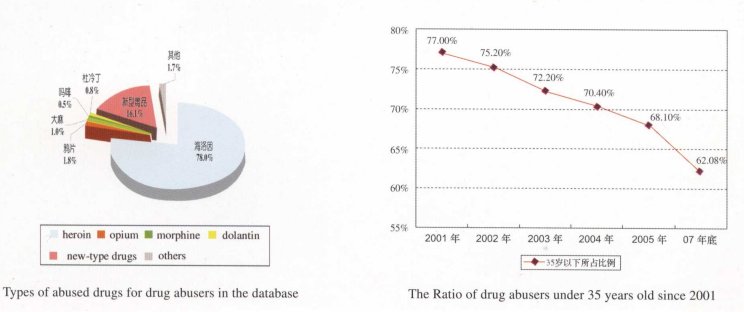
Promoting vigorously the establishment of drug rehabilitation centers and exploring actively new routes of drug treatment and rehabilitation

Mr. Zhang Xinfeng inspects the construction of drug rehabilitation centers
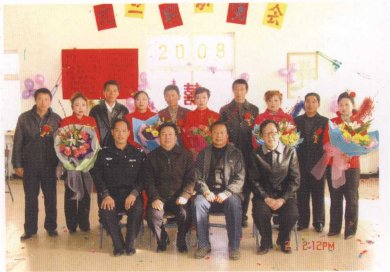
Collective wedding ceremony in Wuzhong Drug Rehabilitation Center of Ningxia Autonomous Region
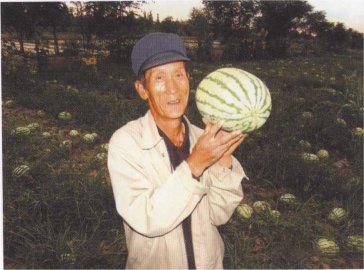
Watermelon harvest in Wuzhong Drug Rehabilitation Center of Ningxia Autonomous Region

Sanya Drug Rehabilitation Center under construction
The party committees and governments of all places attached high importance to the establishment of drug rehabilitation centers, and quickened the pace of designing and constructing drug rehabilitation centers. The vast majority of the 15 piloting projects deployed by the State Development and Reform Commission to public security agencies in 2006 had started their construction, some of them began to accept ex-drug abusers. The 8 piloting projects deployed to the Ministry of Justice had been completed. In 2007, the State Development and Reform Commission, the Ministry of Public Security and the Ministry of Justice developed the "Construction Plan of Piloting Projects of Local Drug Rehabilitation Centers in China", and delivered the investment plan within the central budget for the construction of 23 drug rehabilitation piloting centers as the first phase. The Ministry of Public Security and the Ministry of Justice convened national working meetings respectively for mobilization and deployment. Currently, the vast majority of the 23 piloting projects were proceeding smoothly. The Compulsory Drug Treatment Center of the Kunming Public Security Bureau of Yunnan Province reconstructed the former dormitories of policemen for drug rehabilitation inmates by self-financing before the investment of central construction budgets; more than 300 ex-drug abusers were accommodated. While emphasizing the construction of Sanya Drug Rehabilitation Center, Hainan Province required each county with more than 1000 drug abusers establish drug rehabilitation centers suitable to local situations. Sanya City of Hainan Province permitted the inmates of drug rehabilitation centers to participate in medical insurance and industrial injury insurance and to receive the baseline living subsidy, all funds needed were incorporated to annual financial budget of the city. Haikou City developed the preferable policy for those enterprises and institutes participating in drug rehabilitation. All places mobilized actively the ex-drug users to get rehabilitated in drug rehabilitation centers. Incomplete statistics showed that, by the end of 2007, the ex-drug users in the completed or uncompleted drug rehabilitation centers accumulated to more than 3000. There had been 30 drug rehabilitation centers whose mainactivities were crop cultivation, animal breeding or handiwork, and there had been such model centers as Tiantanghe of Beijing, Sanya of Hainan, Kunming and Kaiyuan of Yunnan, Wuzhong of Ningxia. Some enterprises and social organizations provided support for the construction and development of drug rehabilitation centers in various ways such as supplying funds or making products jointly.

Continuing to strengthen drvg treatment for the significant contraction of drug consumption market
Public security agencies of all places continued to strengthen the drug treatment and rehabilitation according to the deployment of NNCC. By the end of November, 249629 drug abusers had been treated in compulsory treatment centers, while 62163 were sent to labor camp to get treatment. From the middle of September to the end of 2007, Beijing launched a three-month operation to treat all drug abusers in Beijing. Gansu Province treated 4644 drug abusers in compulsory centers and 1046 in labor camp centers. There had been 20233 ex-drug abusers who abandoned drug addiction for more than 3 years. The number of drug abusers in compulsory centers and ex-drug abusers staying away from drugs for more than three year increased by 9.71% and 3.49 respectively compared with those in the 2006. All places took active measures to solve the problems of living and medical expenses of the inmates in compulsory drug treatment centers. Guizhou Province and Wenzhou of Zhejiang Province began to bring the living and medical expenses of the inmates in compulsory drug treatment centers into government financial budgets. Yunnan Province organized the inmates in drug treatment centers to participate in rehabilitation work so as to supplement their medical and living expenses. The compulsory drug treatment centers at all places also implemented the requirement of "first-level compulsory drug treatment center should open drug rehabilitation area based on current situation and organize inmates to take part in rehabilitation work", incorporated rehabilitation labor into the annual examination indicators, and explored actively the rehabilitation models with local characteristics.

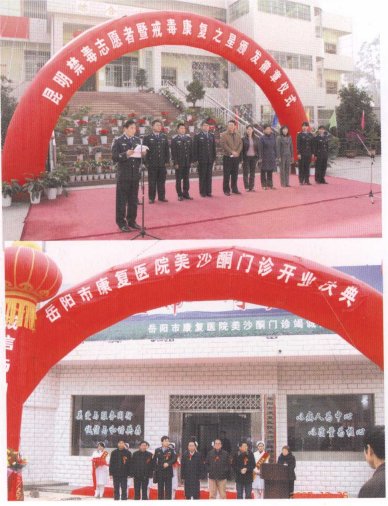
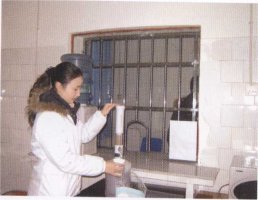
A methadone maintenance clinic in Hunan Province
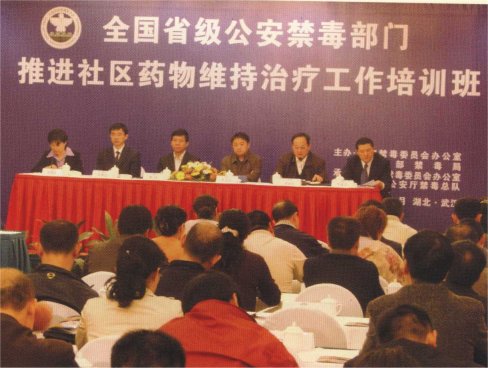
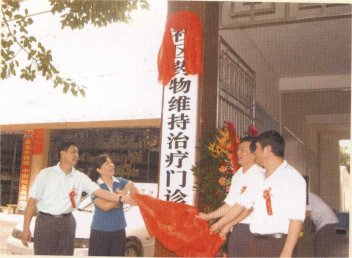
The opening ceremony of Haikou Community-based Methadone Maintenance Clinic of Hainan Province
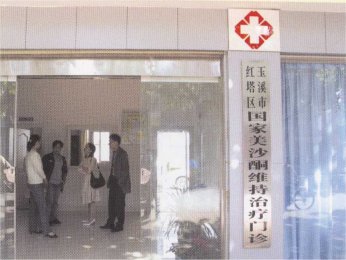
Constantly expanding the coverage of drug maintenance treatment, promoting new developments on reducing drug harms
The Office of NNCC coordinated actively with the National Taskforce on Community-based Methadone Maintenance and Treatment, studied issues such as expanding the coverage, lowering clinic charges, etc, strengthened examination and guidance, issued the "Working Progamme on the Examination, Inspection and Guidance of Community-based Drug Maintenance and Treatment", with special focus on the inspection upon the relevant work in Yunnan and other provinces. Public security agencies at all places cooperated actively with health and drug administration agencies, carefully arranged the setup of drug maintenance and treatment clinics as well as the approval and monitoring of patients. The relevant work had made great progresses. By the end of December, there had been 503 community-based drug maintenance and treatment clinics in 23 provinces, autonomous regions and municipalities, totally 98 thousand drug abusers were treatment, which had made obvious achievements in shrinking drug consumption market and reducing drug harms. In November, the Ministry of Health, the Ministry of Public Security and the SFDA jointly held the annual work summarization meeting in Wuxi City of Jiangsu Province, which was also a scene meeting to extend and exchange successful experiences of Wuxi and other places. In December, the Office of NNCC and the Narcotics Control Bureau of MPS held a training course for provincial narcotics control police in China and issued the "Notice on Promoting Community-based Drug Maintenance and Treatment", which required the regions with drug maintenance practice launch a general training program. According to the statistics from health agencies, by the end of October 2007, among all HIV infectors and AIS patients added up, 38.5% were infected through Injecting Drug Use (IDU); among the newly registered HIV infection in 2007, 29.4% were infected through IDU, the rate was much lower than that infected through sexual activites.

Advanced figures in establishing drug-free communities in Gansu Province
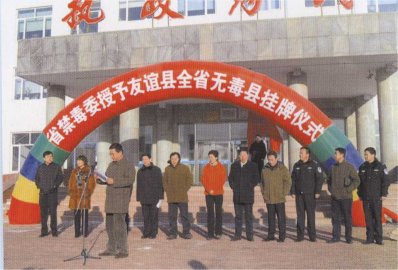
Heilongjiang Province grants titles or drug-free counties
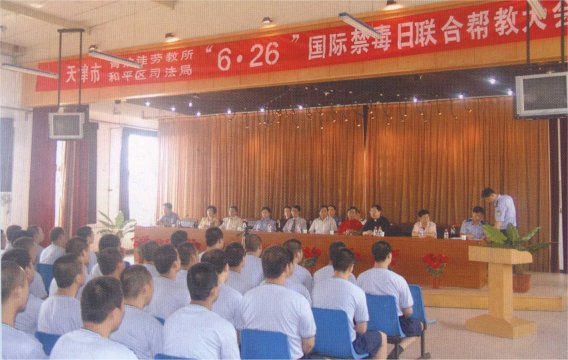
Mobilizing social resources for drug of drug-free communities
All places promoted thoroughly the establishment of drug-free communities. Sichuan, Yunnan, Liaoning, Zhejiang, Hubei, Gansu, etc adopted various forms such as holding scene meeting and examination and evaluation, to strengthen the establishment of drug-free communities. In order to bring into full play the advantages of women's organization, the office of NNCC and the All China Women's Federation jointly launched the operation of "establishing piloting area of drug-free households" in 22 key counties of 8 provinces such as Fujian, Hunan and Guangxi. Sichuan held a training course on establishing piloting area of drug-free households, the duty officers of narcotics control agencies and women's federations in 9 key piloting areas were trained. Guangdong Province began the piloting project of "Treating and Caring One Thousand Drug Abusers", chose one thousand drug abusers in the province and assigned after-care groups for each drug abusers. Shanghai, Gansu, Yunan and Jiangsu organized professional social worker teams of to help the governments to provide aftercare for drug abusers.

Yuxi City of Yunnan Province helps and educates drug abusers in treatment
All places explored actively the establishment of linkage system between compulsory drug treatment and community after-care. Gansu Province established the linkage system and implemented monitoring measures for all Gansu-born drug abusers after treatment, and 88% of drug abusers of Gansu Province were under monitoring in 2007. Kunming City of Yunnan Province developed a drug abusers seamless monitoring working mechanism, provided social correction for all drug abusers of the city, and required relevant agencies to provide a whole-course monitor and assistance for drug abusers and reduce relapse of drug addiction effectively. Sanya City of Hainan Province started the piloting project on seamless linkage for the after-care of drug abusers who finished compulsory drug treatment. Up to the end of 2007, totally 158 thousand drug abusers received after-care, among which 67 thousand had stayed away from drug addiction for more than three years.

Extending regards to drug abusers in treatment
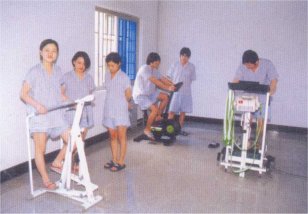
Tianjin Municipality organizes body exercise for drug abusers in rehabilitation
| < Prev | Next > |
|---|












